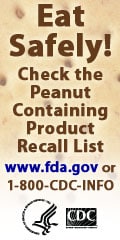Salmonellosis, or salmonella, is one of the most common foodborne diseases. Overall, salmonella infections are decreasing in the United States, but some types are still increasing.
Salmonella may occur in small, contained outbreaks in the general population or in large outbreaks in hospitals, restaurants, or institutions housing children or the elderly. While the disease is found worldwide, health experts most often report cases in North America and Europe. Every year, the Centers for Disease Control and Prevention (CDC) receives reports of 40,000 cases of salmonellosis in the United States.
Children are the most likely to get salmonellosis. The elderly, infants, and those with compromised immune systems are more likely to have a severe illness. People with AIDS are particularly vulnerable to salmonellosis, often suffering from recurring episodes.
CauseMany types of Salmonella bacteria cause salmonellosis in animals and people. While the occurrence of different types of Salmonella varies from country to country, S. typhimurium and S. enteritidis are the two most commonly found in the United States.
An antibiotic-resistant strain of S. typhimurium, called Definitive Type 104 (DT104), was first found in the United Kingdom and then in the United States. It is the second most common strain (after S. enteritidis) of Salmonella found in humans. This strain poses a major threat because it is resistant to several antibiotics normally used to treat people with salmonella disease.
TransmissionSalmonella bacteria can be found in food products such as raw poultry, eggs, and beef, and sometimes on unwashed fruit. Food prepared on surfaces that previously were in contact with raw meat or meat products can, in turn, become contaminated with the bacteria. This is called cross-contamination.
In recent years, Centers for the Disease Control and Prevention has received reports of several cases of salmonella from eating raw alfalfa sprouts grown in contaminated soil. You also can get salmonella after handling pets, particularly reptiles like snakes, turtles, and lizards.
Salmonella can become a chronic infection even if you do not have symptoms. In addition, though you may have no symptoms, you can spread the disease by not washing your hands before preparing food for others. In fact, if you know you have salmonella, health care experts recommend you do not prepare food or pour water for others until laboratory tests show you no longer carry Salmonella bacteria.
SymptomsThe following symptoms usually begin from 12 hours to 3 days after you are infected.
- Diarrhea
- Fever
- Abdominal cramps
- Headache
These symptoms, along with possible nausea, loss of appetite, and vomiting, usually last for 4 to 7 days. Symptoms are most severe in the elderly, infants, and people with chronic conditions such as diabetes or HIV infection.
DiagnosisYour health care provider can use laboratory tests to identify Salmonella in your stool if you are infected.
TreatmentIf you are like most people with salmonella, the disease will clear up within 5 to 7 days and you won’t need to be treated. If you have severe diarrhea, however, you may need intravenous fluids. If the disease spreads from your intestines into your bloodstream, your health care provider can treat it with antibiotics such as ampicillin.
Prevention
- Don’t drink milk that is unpasteurized.
- Don’t eat foods containing raw eggs, such as homemade caesar salad dressing, cookie dough, and hollandaise sauce, or drink homemade eggnog made with raw eggs.
- Handle raw eggs carefully.
- Keep eggs refrigerated.
- Throw away cracked or dirty eggs.
- Cook eggs thoroughly.
- Cook poultry products to an internal temperature of 170 degrees Fahrenheit for breast meat and 180 degrees Fahrenheit for thigh meat.
- Wash thoroughly with soap and hot water all food preparation surfaces and utensils that have come in contact with raw poultry or raw eggs.
- Wash hands immediately after handling raw poultry or raw eggs.
- Wash hands immediately after handling reptiles or having contact with pet feces.
ComplicationsReiter’s Syndrome
While most people recover successfully from salmonella, a few may develop a chronic condition called Reiter’s syndrome. This syndrome can last for months or years and can lead to arthritis. Its symptoms are painful joints, irritated eyes, and painful urination. Unless treated properly, Salmonella bacteria can escape from the intestine and spread by blood to other organs, sometimes leading to death.
Typhoid FeverS. typhi bacteria can cause typhoid fever, a more serious disease. This disease, which can be fatal if untreated, is not common in the United States. Typhoid fever frequently occurs in developing countries, when people become infected from contaminated water. It’s also a risk in areas where flooding or earthquakes cause sewer systems to overflow.
Appropriate antibiotics usually are effective for treating typhoid fever, although the number of cases of antibiotic-resistant S. typhi are increasing in some parts of the world.
----
This article is in the public domain and was reproduced from the website of the National Institutes of Health. The original article can be found
by clicking here.






